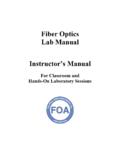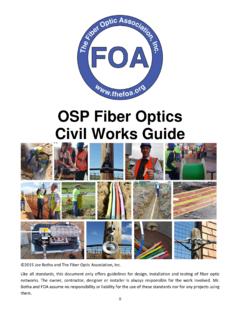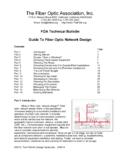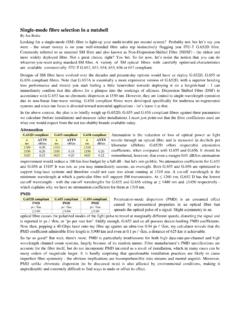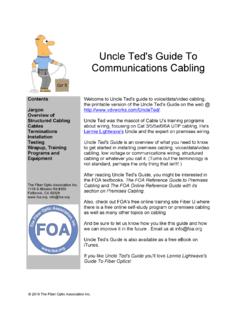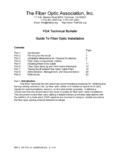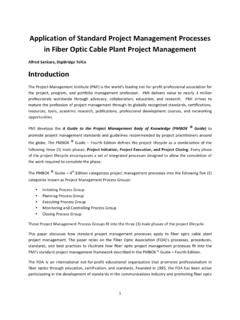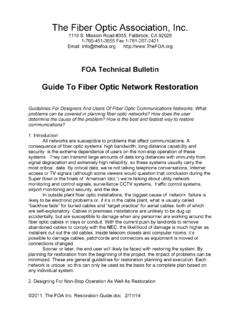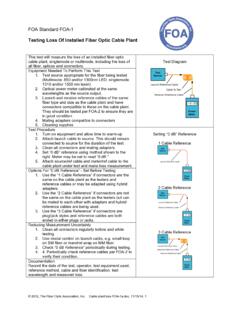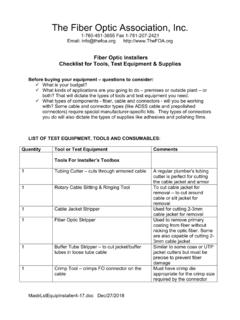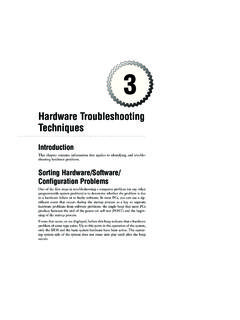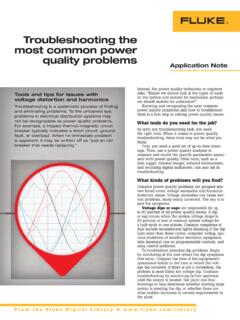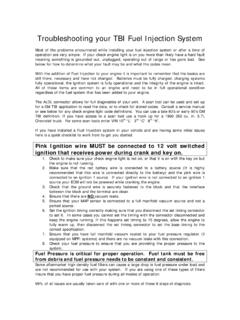Transcription of The Fiber Optic Association, Inc.
1 The Fiber Optic association , Inc. 1-760-451-3655 Fax 1-781-207-2421 Email: 2019, The FOA Inc. Technical Bulletin Guidelines For Testing And Troubleshooting Fiber Optic Installations This is intended as an overview and installation checklist for all managers, engineers and installers on the overall process of testing and troubleshooting a Fiber Optic communications system. This document is based on the FOA books (see references) and the FOA Online Reference Guide. You should also download a copy of the NECA/FOA 301 Fiber Optic installation standard as a reference. 1. Once a Fiber Optic cable plant, network, system or link is installed, it needs to be tested for four reasons: a. to insure the Fiber Optic cable plant was properly installed to specified industry standards. b. to insure the equipment intended for use on the cable plant will operate properly on the cabling c. to insure the communications equipment is working to specifications d. to document the cable plant and network for reference in case of future problems 2.
2 Tools and Test Equipment Needed The following tools are needed to test and troubleshoot the Fiber Optic cable plant, system or link properly. a. Optical Loss Test Set or power meter and test source with optical ratings matching the specifications of the installed system ( Fiber type and transmitter wavelength and type) and proper connector adapters. An OLTS that merely tests cable plant loss may not include a calibrated power meter needed for testing transmitter and receiver power, so a calibrated power meter and source are a better choice for link or system testing. b. Reference test cables with proper sized Fiber and connectors and compatible mating adapters of known good quality. These do not generally need to be reference quality but only in good condition, generally defined as having connector losses of less than dB. c. Visual Fiber tracer and/or visual fault locator (VFL) d. Connector inspection microscope with magnification of 100-200X and fixturing for proper connectors.
3 Video microscopes are recommended. e. Cleaning supplies intended specifically for the cleaning of Fiber Optic connectors. f. Optional: OTDR with long launch and receive cables (100 m for Multimode, 1 km or more for singlemode) 2019, The FOA Inc. 12/25/18 p2 3. Testing And Troubleshooting The Installed Cable Plant All Fiber cable plants require certain basic tests to insure they were installed correctly and meet expected performance values. These are guidelines for testing and troubleshooting the cable plant itself. The most valuable data one can have for troubleshooting is the installation documentation. Note - Cleaning: Before any testing, connectors should be cleaned carefully to ensure that no dirt is present on the end face of the connector ferrule as this will cause high loss and reflectance. Protective caps on connectors, often called dust caps some say that s because they usually contain dust do not necessarily keep connectors clean. Use cleaning supplies intended for cleaning Fiber Optic connecotrs only as other materials my leave residue or cause harm to the connectors.
4 What Can Go Wrong? There are a number of possible problems with Fiber Optic cable installations that are caused by installation practice. These include: a. Damage to the cable during installation caused by improper pulling techniques (such as not pulling the Fiber cable by the strength member,) excess tension, tight bends under tension, kinking or even too many bends. Most of these problems will be seen on all fibers in the cable. b. Damage to the fibers in the cable during cable preparation for splicing or termination. Fibers may be broken or cracked during cable jacket or buffer tube removal or Fiber stripping. This may affect all fibers in the cable or buffer tube or just one Fiber . c. High loss splices caused by improper splicing procedures, especially poor cleaving on mechanical splices or improper programming of fusion splicers. Most fusion splicers give feedback on most problems if the operator is properly trained. Individual fibers can be damaged when being placed in splice trays or tubes of fibers damaged during placement in splice closures.
5 D. High loss connectors may be caused by bad processes or damage after termination. Adhesive/polish connectors may have poor end finishes or cracks in the Fiber at the end of the ferrule or internally. Prepolished/splice connectors are generally high loss due to poor mechanical splicing processes during termination causing high internal loss. Testing And Troubleshooting Steps For Installed Cable Plants FOA Standard FOA-1: Testing Loss of Installed Fiber Optic Cable Plant, (Insertion Loss, TIA OFSTP-14, OFSTP-7, ISO/IEC 61280, ISO/IEC 14763, etc.) FOA Standard FOA-4: OTDR Testing of Fiber Optic Cable Plant (TIA FOTP-8/59/60/61/78, ISO/IEC 14763, etc.) FOA Standard FOA-2: Testing Loss of Fiber Optic Cables, Single Ended, (Insertion Loss, TIA FOTP-171, OFSTP-7, , ISO/IEC 14763) Before installation, it is advisable to test all cable as received on the reel for continuity using a visual tracer or fault locator. Cables showing signs of damage in shipment may need OTDR testing to determine if the cable itself is damaged.
6 Obviously, no cable showing damage should be installed. 2019, The FOA Inc. 12/25/18 p3 Test insertion loss after installation a. After installation, splicing (if applicable) and termination, all cables should be tested for insertion loss using a source and meter or OLTS (optical loss test set) according to standards OFSTP-14 for multimode Fiber , OFSTP-7 for singlemode Fiber . See FOA Standards for simplified explanations of these standards: b. Generally cables are tested individually (connector to connector for each terminated section of cable and then a complete concatenated cable plant is tested end-to-end , excluding the patchcords that will be used to connect the communications equipment which are tested separately. c. It is the concatenated cable test that is used to compare to the link power budget and communications equipment power budget to insure proper operation. d. Insertion loss testing should be done at the wavelength of intended operation if known or at two wavelengths with appropriate sources (850/1300 nm with LEDs for multimode Fiber , 1310/1550 nm with lasers for singlemode Fiber , 1490 for FTTH.))
7 E. Unless standards call for bi-directional testing, double-ended testing with both launch and receive cables (OFSTP-7/14) is adequate. f. Data on insertion loss of each Fiber should be kept for future comparisons if problems arise or restoration becomes necessary. Recording data on a label inside the patchpanel or enclosure is common practice. g. Long cables with splices may be tested with an OTDR to confirm splice quality and detect any problems caused during installation, but insertion loss testing with an OLTS (light source and power meter) is still required to confirm end-to-end loss. Cables with insertion loss near expected values do not also need OTDR testing. Cables tested with an OTDR should have the data kept on file for future needs in restoration. Troubleshooting a. First determine if the problem is with one or all the fibers in the cable. If all fibers are a problem , there is a likelihood of a severe cable installation problem . If all fibers are broken or have higher than expected loss, an OTDR will show the location of the problem on longer cables but premises cables may be too short and need physical inspection of the cable run.
8 If the problem is caused by kinking or too tight a bend, the cable will have to be repaired or replaced. Generally OSP cables will be spliced as in a restoration and if the cable is a short OSP cable or a premises cable, replaced. b. High loss fibers have several potential causes, but bad splices or terminations are the most likely cause for field terminated cables. In some cases, using improper termination practices will result in high loss for all fibers, just as in kinking or bending losses, not just one Fiber . c. Testing for high loss fibers should start with microscope inspection of terminations for proper polish, dirt, scratches or damage. d. If dirt appears to be the problem , clean the connectors and retest. e. If other connector damage is found on visual inspection, retermination will probably be necessary. Sometimes scratches can be polished out with diamond film by an experienced technician. 2019, The FOA Inc. 12/25/18 p4 f. Prepolished splice connectors with internal splices will generally look OK when inspected with a microscope unless damaged after installation.
9 The most likely cause of loss with these connectors is high splice loss in the internal splice. They can be tested with a visual fault locator coupled into the Fiber at the far end. High light loss will be seen as an illumination of the connector ferrule. Some connectors have translucent backshells and can be tested with a VFL coupled directly into the connector. g. If the reason for high loss is not obvious and the connectors are adhesive/polish style, the problem may be a Fiber break in the back of the connector. A VFL may help in finding Fiber breaks, depending on the connector style and the opacity of the cable jacket. h. Cables with a Fiber or fibers showing very high loss or no light transmission at all should be tested for obvious breaks in the pigtail Fiber or cable, generally at the splice or connector, with a visual fault locator or high resolution OTDR if the cable is of sufficient length i. Splice loss problems can be pinpointed during OTDR testing.
10 Confirmation with a VFL should be done if the length from the end of the cable is short enough (~2-3 km) where a VFL is usable. The VFL can find high loss splices or cracks in fibers caused by handling problems in the splice tray. j. High loss links where the excessive loss is only a few dB can be tested like a patchcord with a single-ended test with a source and power meter. When tested in this manner, a high loss connector will show high loss when connected to the launch cable connector but not when connected directly to the power meter detector which picks up all the light from the Fiber . Hints for troubleshooting a. Having access to design specifications and installation documentation and specifications will greatly assist troubleshooting. b. If possible, interview the installer to help uncover processes that may lead to issues in installation, such as pulling methods, lubrication, intermediate pulls, splicing or termination methods (like improper field termination of singlemode which can lead to high loss and reflection even when connectors look OK in a microscope.)
